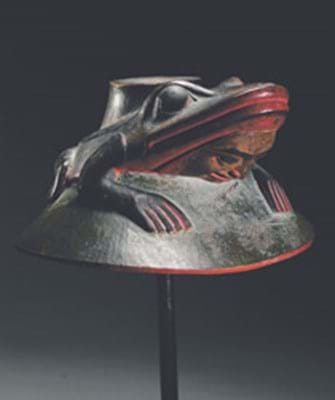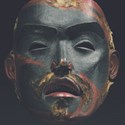A year later, on the morning of October 26, 1863, the visiting Reverend Robert J. Dundas and Lieutenant Commander E.H. Verney sat on the beach at Metlakatla examining more than 80 "Indian curiosities" that Father Duncan had assembled for them, including everything from carved ladles and masks to crests and soul catchers.
As part of their conversion to Christianity, the Natives had relinquished cherished possessions relating to their traditional 'pagan' way of life. The Reverend Dundas eventually returned with them to his native Scotland.
The Dundas collection was passed down through generations although it was not until 1959, when they came into the possession of Robert J. Dundas' great-grandson Simon Carey that they were researched and their significance and value understood.
It became clear that the collection included some of the finest examples of Northwest Coast art in existence, the earliest pieces dating from the 18th century. It was also one of the many great American Indian discoveries made in Scotland - the Reverend Dundas was not the only Presbyterian missionary to admire the former trappings of converted tribes.
Over the past three decades, Mr Carey has negotiated to sell the family collection with some of the world's top cultural institutions, including the Metropolitan Museum of Art in New York and the British Museum.
Either because they couldn't meet his price or his wishes for the objects to go on permanent display as a stand-alone collection and publish the 250,000-word accompanying journals of Reverend Dundas, he was unable to settle on a deal.
Instead, 143 years after those magnificent 'curiosities' came into the family, Mr Carey decided to part with the Dundas Collection of Northwest Coast American Indian Art in 57 lots at Sotheby's New York on October 5.
Amidst a blaze of publicity, Canadian institutions scrambled to find funds to bring it home but without last-minute government funding it looked bleak.
Toronto based tribal art dealer Donald Ellis told the Canadian national press: "I'm a proud Canadian but I'm tired of the expectation that the government should fund our cultural patrimony entirely. In the USA, museums would go directly to a private buyer for a donation. That's how you get things done these days."
And a white knight did appear. Mr Ellis's comments prompted David Thomson, son of the late media mogul and art collector Kenneth Thomson, to spend $5m (£2.8m) on a major portion of the collection. Bidding throught Donald Ellis, he secured eight of the top ten lots, all of which are now expected to find a permanent home in the Art Gallery of Ontario.
The Thomson family purchases included the top lot, a magnificent Tsimshian polychromed wood portrait mask representing a shaman spirit that fetched $1.6m (£892,000), an auction record for an American Indian object. At least two other Canadian museums secured a further six items and at the end of the day all of the lots had found buyers and the $6m (£3.35m) total had set a record for a sale of American Indian Art at auction.
Robert J. Dundas's extensive diaries were not part of the sale, but the Thomsons' are hoping to purchase them to keep much of the archive intact.
Mission to save a collection
In 1862, the English missionary Father William Duncan brought around 70 Tsimshian Christian converts to an abandoned Native village and established a model Church of England mission settlement at Metlakatla in Northern British Columbia.








